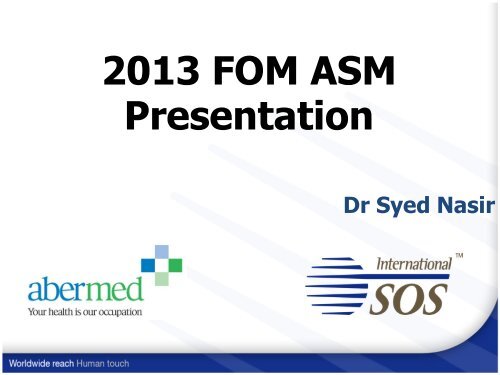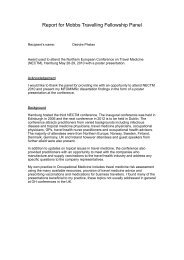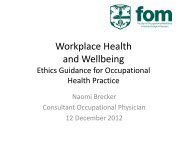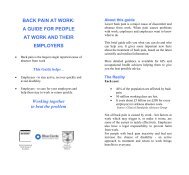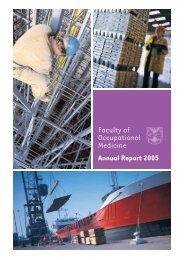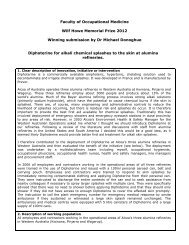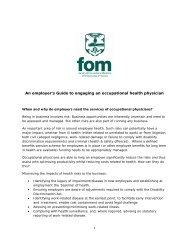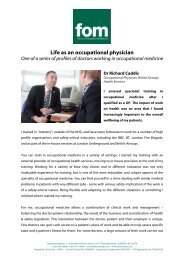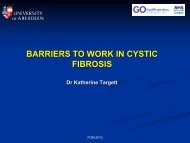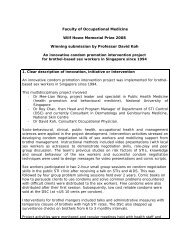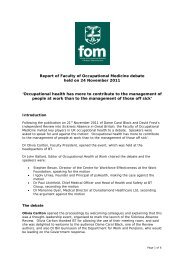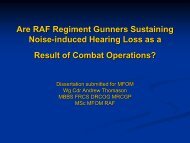Dr Syed Nasir
Dr Syed Nasir
Dr Syed Nasir
Create successful ePaper yourself
Turn your PDF publications into a flip-book with our unique Google optimized e-Paper software.
2013 FOM ASM<br />
Presentation<br />
<strong>Dr</strong> <strong>Syed</strong> <strong>Nasir</strong>
The Respiratory Health of<br />
Cleaners in NHS Highland
Background<br />
• Previous studies found<br />
increased risk of lower<br />
respiratory symptoms in<br />
cleaners compared to<br />
administrative staff.
Previous Research<br />
• Largest data set on cleaners<br />
from ECRHS (European<br />
Community Respiratory Health<br />
Survey) study – 26 centres in<br />
12 countries.<br />
• Spanish EPIASLI, Canadian<br />
cross-sectional surveys.<br />
• Swedish, Singapore, New<br />
Zealand surveys.<br />
Accessed from: http://www.ecrhs.org/ECRHS%20I.htm<br />
• National surveillance schemes<br />
across 4 continents.
NHS Highland Cleaners<br />
• 6% of NHS Highland employees.<br />
Vital in protecting health of<br />
patients and staff.<br />
• Exposure to occupational<br />
respiratory hazards such as<br />
cleaning agents and dust.<br />
• In NHS Highland cleaners had<br />
higher sickness absence and<br />
staff turnover rates than<br />
administrative staff.
NHS Highland features<br />
• Single Health Board with<br />
discrete, standardised<br />
working conditions.<br />
• Covers 40% of Scottish<br />
mainland area in<br />
Northwest.
Objectives<br />
• To estimate the<br />
prevalence of respiratory<br />
symptoms among<br />
cleaners compared with<br />
administrative workers.<br />
• To identify any<br />
associations between<br />
specific occupational<br />
exposures and<br />
respiratory symptoms<br />
among cleaners.
Method<br />
• Cross-sectional postal<br />
questionnaire survey of:<br />
- All NHS Highland cleaners.<br />
- Comparison group of all<br />
NHS Highland<br />
administrative staff.<br />
• 2 nd mailing to nonresponders.
Questionnaire<br />
• Respiratory symptoms<br />
questions from the validated European<br />
Community Respiratory Health Survey<br />
(ECRHS) questionnaire.<br />
• Exposure<br />
asked about history of cleaning work;<br />
cleaning agents; cleaning tasks; duration of<br />
work as a cleaner; cleaning locations and<br />
training on the use of cleaning agents.
Results : Response Rate<br />
• The overall response rate was 56%:<br />
-645/1270 administrative staff (62%).<br />
-216/545 cleaners (40%).
Demographic profiles<br />
• No significant difference between the<br />
groups in terms of the age distribution<br />
(p=0.075) or gender distribution<br />
(p=0.19).<br />
• A significantly greater proportion of<br />
administrative staff were educated<br />
beyond secondary school level<br />
(p
Smoking profiles<br />
• Greater proportion of<br />
cleaners had ever<br />
smoked (52% vs<br />
34%).<br />
• Comparing the packyears<br />
of smoking in the<br />
two groups, cleaners<br />
smoked statistically<br />
significantly more than<br />
the administrative staff<br />
[p=0.003]
Power of study<br />
• 80% power at a 0.05 significance<br />
level, to detect a 9% difference in the<br />
prevalence of asthma or chronic<br />
bronchitis symptoms.<br />
• Greater than the pre-study projection.
Key findings<br />
• After adjusting for age and smoking,<br />
no significant differences were<br />
found in the occurrence of asthma<br />
and chronic bronchitis in cleaners<br />
compared to administrative staff.<br />
• Cleaners had significantly less upper<br />
respiratory tract symptoms<br />
(allergic rhinitis).
Risk of respiratory<br />
symptoms : adjusted odds<br />
ratio<br />
Cleaners<br />
[OR (95%CI)]<br />
Administrative<br />
staff (never<br />
cleaners)<br />
Wheezing with<br />
breathlessness<br />
0.81 (0.44-1.44) 1.0<br />
Ever asthma 0.65 (0.39-1.04) 1.0<br />
Current asthma 1.25 (0.80-1.92) 1.0<br />
Chronic bronchitis 1.26 (0.79-1.97) 1.0<br />
Ever rhinitis 0.59 (0.41-0.86) 1.0
Exposures : Cleaning<br />
agents<br />
• No significantly increased risk of<br />
asthma or chronic bronchitis<br />
symptoms with any of the chlorinecontaining<br />
cleaning agents.
Exposures : Chlorine –<br />
based agents<br />
Cleaning substance<br />
Current asthma<br />
[OR (95%CI])<br />
Actichlor 1.56 (0.73-3.45)<br />
Cleenol bleach 1.11 (0.39-2.81)<br />
Precept 2.13 (0.44-8.13)
Exposures : Cleaning<br />
tasks<br />
• No significantly increased risk with<br />
dusting/polishing furniture or cleaning<br />
up chemical spills of current asthma or<br />
chronic bronchitis.<br />
• Dusting/polishing furniture<br />
-current asthma OR 2.76, 95% CI 0.63 – 12.23<br />
-chronic bronchitis OR 1.07, 95% CI 0.38 – 3.01.<br />
• Cleaning up chemical spills<br />
-current asthma OR 1.37, 95% CI 0.59 – 3.19<br />
-chronic bronchitis OR 1.88, 95% CI 0.86 – 4.10.
Exposures : Cleaning<br />
Areas<br />
• No significantly increased risk in<br />
operating theatres, hospital wards,<br />
kitchens and corridors:<br />
– Asthma [OR 1.11, 95%CI 0.45–3.18]<br />
– Chronic bronchitis [OR 0.95, 95%CI 0.40 – 2.54]
Risk by Geographical Area<br />
• No significantly<br />
increased risk of<br />
current asthma or<br />
chronic bronchitis<br />
symptoms by area<br />
(4 CHPs).
Discussion<br />
• First epidemiological study of respiratory<br />
symptoms in cleaners working with<br />
standardised working conditions,<br />
substances and training in a large<br />
healthcare organisation.
Possible explanations<br />
• The preventive measures put in place<br />
by NHS Highland addressed many risk<br />
factors highlighted by previous<br />
studies.
Hierarchy of Control<br />
ELIMINATION Sprays, Enzymatic/Biological agents, Sanitiser powder,<br />
Fume-emitting Destainer, Bactericidal gel.<br />
Introduction of Steam cleaner using hot water-avoids use<br />
of chemicals.<br />
SUBSTITUTION Lower chlorine concentrations in cleaning agents<br />
ENGINEERING Use of enclosed bucket to dissolve chlorine-based tablet in<br />
tepid water<br />
ADMINISTRATIVE Colour coding of cleaning equipment/areas (NPSA)<br />
Standard Procurement Process<br />
HAI/HEI audits<br />
INFORMATION,<br />
INSTRUCTION,<br />
TRAINING<br />
NHS Highland-wide trainers<br />
Standard training programme for cleaners<br />
Framework of NHS Scotland Policies (Cleaning Services ,<br />
Agenda for Change, Cleaner Education and Training),<br />
Cleanliness Champions<br />
PPE Risk-assessed: Masks, Gloves, Uniform
Other factors<br />
• Median length of service of cleaners (6<br />
years).<br />
• Mean age of cleaners (47.3 years) less<br />
than the peak age for diagnosis of<br />
COPD (>55 years).
Study strengths<br />
• Discrete, well-defined occupational<br />
groups with homogenous working<br />
conditions.<br />
• Groups well-matched by age, gender.<br />
• Unexposed group never employed as<br />
cleaners.<br />
• Validated ECRHS questionnaire.<br />
• Evaluation of exposures (tasks,<br />
substances, locations).
Study weaknesses<br />
• Low response rate in cleaners (40%)<br />
• Responder bias<br />
• Healthy Worker Effect
Conclusion<br />
• No significant increase in the prevalence of lower<br />
respiratory symptoms in NHS cleaners.<br />
• No significantly increased risks of respiratory<br />
symptoms among cleaners:<br />
– in the highest risk areas<br />
– using chlorine-based cleaning agents<br />
– by cleaning tasks<br />
– by geographical division<br />
• Possible explanations: Risk assessment and<br />
controls; Cleaners’ age and length of service.
Any questions?


